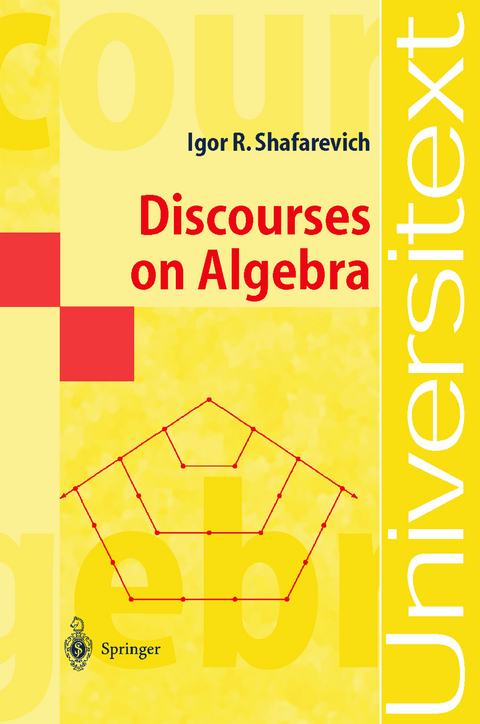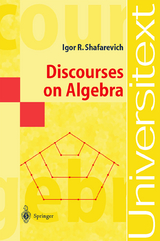Discourses on Algebra
Springer Berlin (Verlag)
978-3-540-42253-2 (ISBN)
I wish that algebra would be the Cinderella ofour story. In the math ematics program in schools, geometry has often been the favorite daugh ter. The amount of geometric knowledge studied in schools is approx imately equal to the level achieved in ancient Greece and summarized by Euclid in his Elements (third century B. C. ). For a long time, geom etry was taught according to Euclid; simplified variants have recently appeared. In spite of all the changes introduced in geometry cours es, geometry retains the influence of Euclid and the inclination of the grandiose scientific revolution that occurred in Greece. More than once I have met a person who said, "I didn't choose math as my profession, but I'll never forget the beauty of the elegant edifice built in geometry with its strict deduction of more and more complicated propositions, all beginning from the very simplest, most obvious statements!" Unfortunately, I have never heard a similar assessment concerning al gebra. Algebra courses in schools comprise a strange mixture of useful rules, logical judgments, and exercises in using aids such as tables of log arithms and pocket calculators. Such a course is closer in spirit to the brand of mathematics developed in ancient Egypt and Babylon than to the line of development that appeared in ancient Greece and then con tinued from the Renaissance in western Europe. Nevertheless, algebra is just as fundamental, just as deep, and just as beautiful as geometry.
1. Integers (Topic: Numbers).- 1. ?2 Is Not Rational.- 2. The Irrationality of Other Square Roots.- 3. Decomposition into Prime Factors.- 2. Simplest Properties of Polynomials (Topic: Polynomials).- 4. Roots and the Divisibility of Polynomials.- 5. Multiple Roots and the Derivative.- 6. Binomial Formula.- 3. Finite Sets (Topic: Sets).- 7. Sets and Subsets.- 8. Combinatorics.- 9. Set Algebra.- 10. The Language of Probability.- 4. Prime Numbers (Topic: Numbers).- 11. The Number of Prime Numbers is Infinite.- 12. Euler's Proof That the Number of Prime Numbers is Infinite.- 13. Distribution of Prime Numbers.- 5. Real Numbers and Polynomials (Topic: Numbers and Polynomials).- 14. Axioms of the Real Numbers.- 15. Limits and Infinite Sums.- 16. Representation of Real Numbers as Decimal Fractions.- 17. Real Roots of Polynomials.- 6. Infinite Sets (Topic: Sets).- 18. Equipotence.- 19. Continuum.- 20. Thin Sets.- Supplement: Normal Numbers.- 7. Power Series (Topic: Polynomials).- 21. Polynomialsas Generating Functions.- 22. Power Series.- 23. Partitio Numerorum.- Dates of Lives of Mathematicians Mentioned in the Text.
From the reviews:
"... What I found particularly attractive about this book are the historical notes, the references to many mathematicians and their work, as well as many original proofs included. In closing: I think that any student and any teacher interested in a deeper study of elementary (and maybe not so elementry) study of such topics as sets, polynomials, and numbers should read (pencil in hand!) this book. It may be particulary valuable for future teachers. The book is very well written, and it has detailed proofs and many exercises. Above all, this book will be remembered for its beauty and elegance." (M. Poplicher, Read This! The MAA Online book review column (for complete review see http://www.maa.org/review/shafarevichdiscourses.html
"... As the book progresses it becomes increasingly clear that the author has planned the development of ideas meticulously, not only so that he can constantly surprise the reader with the next turn of events, but also so that he can demonstrate unexpected links between results in algebra, number theory and probability. There are numerous ideas here for providing stimulating lessons for able pupils as well as for self-study, and the book would make a valuable addition to the school or department library." (G. Leversha, The Mathematical Gazette, 88:511, 2004)
"Since it happens so rarely, one must take notice when a great master of mathematics writes an elementary text. ... Shafarevich takes the subject much farther than any high school text. ... This book could form the basis for a great "transition to abstraction" course and should certainly have a role in programs training high school mathematics teachers. Summing up: Recommended. General readers; lower- and upper-division undergraduates; professionals." (D.V. Feldman, Choice, June 2003)
"... While written for students at the secondary level, the text goes quite thoroughly into foundational matters normally encountered at university ... This book is highly recommended for teenagers with a strong desire to study mathematics and for secondary teachers seeking to contextualize what is on the school syllabus and to appreciate what some of their students will meeet in university mathematics." (Edward J. Barbeau, Zentralblatt für Mathematik 1004.00001)
"Discourses on Algebra is an advanced elementary algebra book intended to supplement the content of algebra courses ... . All the sections in the book are followed by exercises intended to test both the understanding of the material presented and proved in the book, and the creativity and mathematical skills of the readers. ... The book is very well written, and it has detailed proofs and many exercises. Above all, this book will be remembered for its beauty and elegance." (Mihaela Poplicher, MAA Online, September, 2004)
"In this introduction to algebra, the author aims to show that the subjectis no less beautiful, elegant and logically coherent than Euclidean geometry. ... it should appeal to able students and undergraduates who are looking for a more sustained and challenging course in elementary algebra. ... There are numerous ideas here for providing stimulating lessons for able pupils as well as for self-study, and the book would make a valuable addition to the school or department library." (Gerry Leversha, The Mathematical Gazette, 88:511), 2004)
"In this book, the author - a famous Russian algebraist - argues with examples that algebra is no less beautiful, elegant, and logically cohesive than geometry. It contains an exposition of some rudiments of algebra, number theory, set theory and probability presupposing very limited knowledge of mathematics." (Zentralblatt für Didaktik der Mathematik, June 2002)
"In this book, 'the elements of algebra as a field of contemporary mathematics are laid out, based on material bordering the school program as closely as possible'. The author would like algebra to appeal to students in the way that Euclidean geometry does. ... the text goes quite thoroughly into foundational matters normally encountered at university. ... This book is highly recommended for teenagers with a strong desire to study mathematics and for secondary teachers seeking to contextualize what is on the school syllabus and to appreciate what some their students will meet in university mathematics." (Edward J. Barbeau, Zentralblatt MATH, 1004:4, 2003)
| Erscheint lt. Verlag | 19.9.2002 |
|---|---|
| Reihe/Serie | Universitext |
| Zusatzinfo | X, 279 p. 2 illus. |
| Verlagsort | Berlin |
| Sprache | englisch |
| Maße | 155 x 235 mm |
| Gewicht | 458 g |
| Themenwelt | Mathematik / Informatik ► Mathematik ► Algebra |
| Mathematik / Informatik ► Mathematik ► Arithmetik / Zahlentheorie | |
| Schlagworte | Algebra • binomial • integers • Number Theory • polynomials • Prime • Prime number • Sets |
| ISBN-10 | 3-540-42253-6 / 3540422536 |
| ISBN-13 | 978-3-540-42253-2 / 9783540422532 |
| Zustand | Neuware |
| Informationen gemäß Produktsicherheitsverordnung (GPSR) | |
| Haben Sie eine Frage zum Produkt? |
aus dem Bereich




